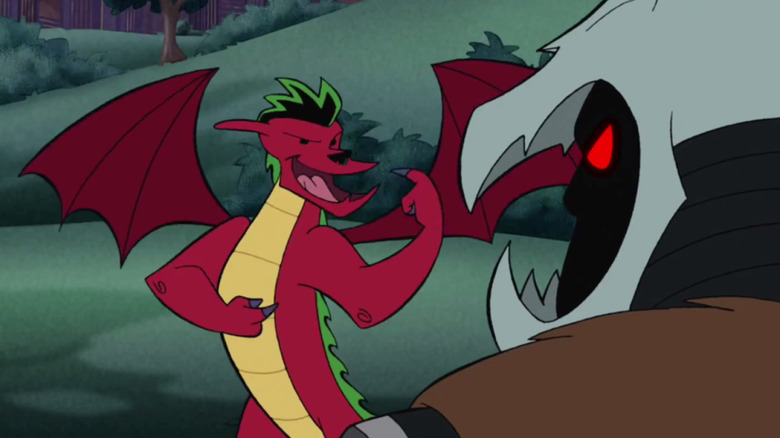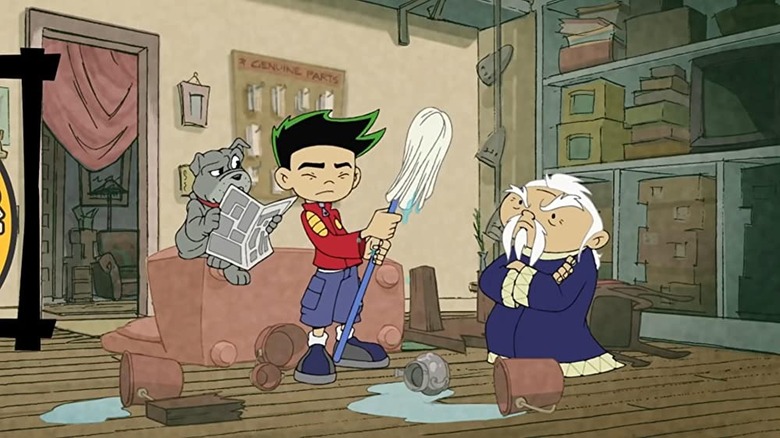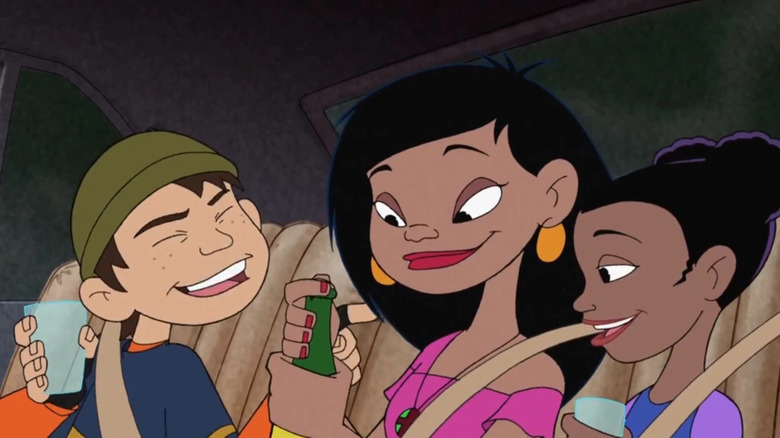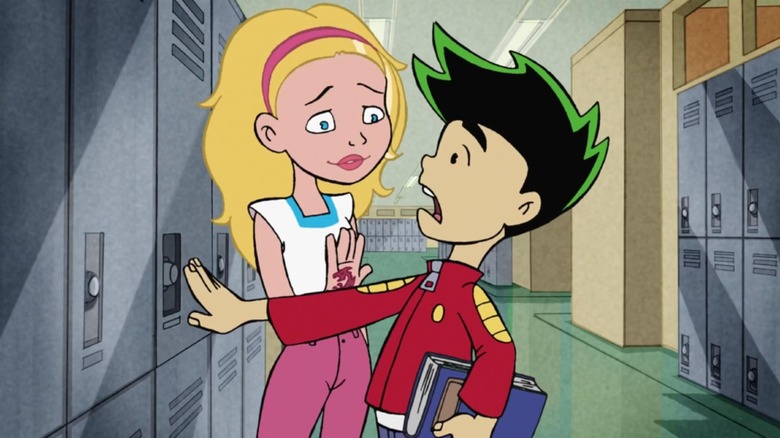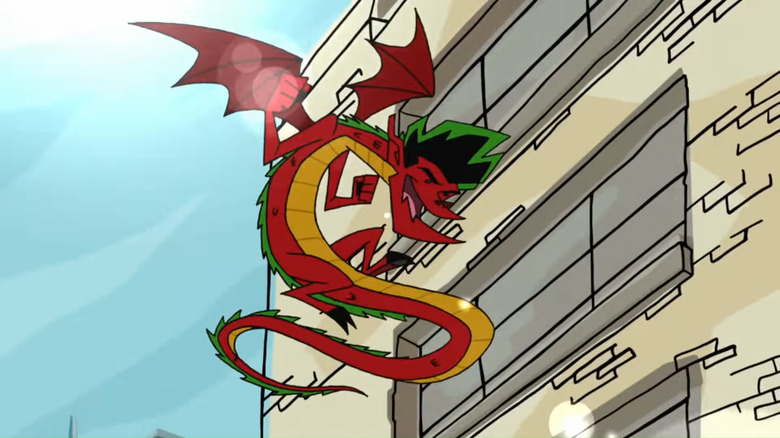American Dragon: Jake Long Creator On World-Building, Hot Tub Seatbelts, And More [Exclusive Interview]
"American Dragon: Jake Long" came at the right time for The Disney Channel. Though not their first fantasy-adjacent show (in many ways, it feels like a successor to "Gargoyles"), it felt like Disney's answer to both "Harry Potter" and "Avatar: The Last Airbender," which came out the same year. This was a hero's journey cartoon about a boy who discovers he's a key part of a massive fantasy world filled with magical creatures, cool villains, and more.
The show followed the titular Jake Long, who is assigned the role of the American Dragon and uses his ability to transform into a dragon to protect the magical creatures that inhabit New York City. Though he still has to find time to go to school and be a normal teenager, he spends his afternoons fighting the evil Huntsman, who wants to kill all magical creatures.
The show was created by Jeff Goode, marking his first animated project as a creator and executive producer. /Film spoke with Goode about the inception of "American Dragon: Jake Long," creating an expansive mythology, and ridiculous network requests. He also spoke about the controversial art style change in season 2, and much more.
A fantasy show about real New York
Goode recalled first coming up with the idea for "American Dragon: Jake Long" around the year 2000 as a pitch for the people at Fox, who were looking for "a show that would appear to the 'Harry Potter' audience." Originally, the show was going to be live-action and aimed at older audiences, with Jake being 18 at the start of the show.
"In the pilot, his parents are murdered by dragon hunters, and so the story was him adventuring across the country trying to find another dragon, and trying to meet magical creatures that lived in different parts of the U.S.," Goode explained. We would meet the trolls under the Brooklyn Bridge one episode, and find the Sasquatch in Idaho in another. Goode described the tone as similar to "Buffy the Vampire Slayer." And a big departure from what the cartoon became was that the Huntsman was not a villain, but Jake's mentor, training him in his dragon-slaying ways while they found a dragon that could teach Jake to be an actual dragon.
As tends to happen, however, the show was not picked up by Fox, and Goode spent a year pitching it around to other studios — including Henson, who Goode said loved the premise but didn't figure out how to make it work with puppets. Eventually, it landed at Disney, but not before several changes had to be made, starting with turning the live-action idea into animation and reversing the decision to kill the parents in the pilot. And rather than a road trip format, Jake had to be home every night, so the story was moved to New York City, a place big enough to house many different cultures and creatures.
Part of what made the show cool was its expansive mythology, which combined folklore from all over the world. Jake would encounter everything from leprechauns to djinn and eventually meet the Dragon Council, comprised of dragons from around the world. This allowed "American Dragon: Jake Long" to appeal to kids no matter where they were from, because they could see fantastical creatures from their cultures either directly represented in the cartoon, or imagine them existing and perfectly fitting this world.
Quickly, the world of the show became bigger, which made for some of the best episodes of the show as well as a few headscratchers for the Disney execs. "Disney wasn't really interested in the World Dragons really at all," Goode explained. "They wanted it to be about a kid in school and school issues. And so every time we had something at the Dragon Council, they would sort of roll their eyes and tell us, 'We really shouldn't be doing — there's too many characters.' But at the same time, they didn't stop us."
Safety first
Though "American Dragon: Jake Long" was not the first attempt by Disney to create a big and expansive fantasy show, it didn't mean that the studio was fully open to doing it again. On the contrary, Disney had notes on even the most basic elements of the premise.
A big part of notes on children's shows are about avoiding imitable behavior, which makes sense because you definitely don't want children setting things on fire or stabbing people, and this is a show with a lot of fighting, blades, and fires. But, as Goode tells it, Disney was very, very adamant about not wanting Jake breathing fire, despite him being a dragon.
"It was always a struggle anytime we had him breathing fire to try to make sure it was something that there's no way a kid would ever try to imitate," the show creator said.
"So for example, in the first episode when he farts fire, that was okay, because that isn't something that a child would do. But we very rarely, it was very hard anytime he was just going to breathe fire as a weapon. We tended to have to come up with something like, 'Oh, he's breathing fire to light a candle, he's breathing fire to do something normal or maybe just don't breathe fire at all.'"
Farting fire? Perfectly fine. Burning an enemy? Big no-no.
It's the same reason why the Huntsman, who used a ton of knives as weapons, never stabbed anyone. "They end up using them more like quarter staffs than blades anyway. So they look nasty, but you don't actually see them fighting with them the way you would fight with an ax."
And because Jake is constantly skating everywhere, he needed to have a helmet, at all times, despite his hair being such an intricate part of his design. But there's safety, and then there's being ridiculous.
The episode "The Legend of Dragon Tooth," in which Jakes misses out on a concert to babysit his sister, ends with popstar Shaniqua Chulavista somehow inviting Jake's best friends, Trixie and Spud ,to party with her in her limo. As Goode tells it, the end tag was even bolder.
"What we had originally was that they're in a limo with a hot tub in back, and they're sitting in the hot tub driving down the street," the creator explained. "Standards and practices came back and said, 'No, if they're sitting in the hot tub, they have to be wearing seat belts.' And so we had to draw, I don't remember if we fully animated this, but we had to storyboard them in a hot tub in the back of a limousine with seat belts on in the hot tub just to show how ridiculous that was."
"And what ended up going on the air is just inside the limousine. But that was one we're like, 'They'll let us be in a hot tub, won't they?' Nope. Got to have seat belts, got to have seat belts. And I thought it was also funny just because it wasn't like they came back and said, 'No hot tubs.' No, no, they were fine with the hot tub. You just had to have a seatbelt on. So I think that's sort of the archetypal example of standards and practices giving us — I mean, that's a great note that is hilarious and so ridiculous, but it happened."
'This is the opposite of Spider-Man'
Like any good superhero story about a kid, or any hero's journey, "American Dragon: Jake Long" is not popular at school. Jeff Goode described Jake as more like Peter Parker, a bullied kid with a secret power who slowly grows to be confident in himself. But there was one executive who had issues with that idea. "This executive looked me dead in the eye and said, 'No, Jeff, this is the opposite of Spider-Man,'" and instead wanted him to be popular. Thankfully, Goode didn't listen.
What is a scrawny hero kid without an animal companion? In the case of Jake, he had Fu Dog, a Chinese Shar Pei. He is funny, is constantly commenting and mocking the situation, and also helps train Jake. But while Fu Dog was a cool part of the cast, he was almost an even bigger and cooler part of it. Goode told us that, originally, the design of Fu Dog had a bigger purpose: He could transform into a Fu Lion or a Chinese guardian lion. "[Fu Dog] would basically unwrinkle as he inflates up to this huge amazing dragon," Goode explained. (They even had designs by Dave Filoni, who would go on to become a huge player in the "Star Wars" galaxy.)
Fu Dog was going to be the big breakout character of the show, a jerk and a jokester that could also become a badass fighter, but it was not meant to be. "The executives came back to us and they didn't really want there to be much magic in the show," Goode said, explaining that the powers that be thought there were too many dragons already (and this is before introducing the council). "They axed Fu Dog because Jake transforms, grandpa transforms, too many transformations. 'We can't have another character that transforms.' And so we were left with just a dog. We were left with a talking dog. And there's this whole other character that no one will ever see because they didn't want to have magical transformation in this show."
Indeed, according to the show creator, the studio, who greenlit the show based on its fantasy inspirations, were not so keen on the fantasy after all. "They really preferred [Jake] not to turn into a dragon during the show. They wanted us to have him turn into a dragon as little as possible. They really wanted it to be about him going to school and having school issues. So that was always a struggle."
Ch-ch-ch-ch-changes
Ask any fan about their thoughts on the show and chances are one of the first things they'll mention are the big changes going into season 2, namely the art style. Most characters had their designs changed, with arguably the biggest departure being Jake's dragon design. He went from essentially a bulky superhero to a thinner, scrawnier dragon.
There have been rumors for years about whether this change was mandated by the studio, and now Goode sets the record straight. It was producer Steve Loter, who worked on the cartoon early on before leaving to work on "Kim Possible," who requested the change in art style. "I have to give Disney credit for even allowing that to happen," said Goode. The reasons for the change were mostly about two things. The first was that Loter's original vision for the look of the show was to have Jake grow and become stronger with time, and the redesign was an attempt to bring this idea back — to have Jake slowly grow to become the bulky dragon from the first season down the line, becoming more of a superhero.
The second reason was a more undervalued one: The new design meant cooler fight scenes. The thinner look meant the animators were allowed to give Jake more dynamic movements and slicker fights, which was more expensive and took longer to animate. "I think that showed their commitment to the show to say, 'We want to do something that it's going to be different, but it will give us more potential down the road and will give us what will ultimately be a better look, but might be a bit jarring for the fans at first.'"
Sadly, the show never expanded beyond that, because it got canceled after its second season. The reason was, simply, math. The Disney Channel at the time had a rule of canceling new shows after 65 episodes for syndication and re-run purposes, a number that was usually reached in the third season. In the case of "American Dragon: Jake Long," the show got longer episode counts in its first two seasons instead. So by the end of the second season, they were so close to Disney's goal, and the animation was getting more and more expensive, that they didn't really need a third season.
"No one did anything bad. It was just that we did so well early on that we sort of accidentally screwed ourselves out of a third season because we got our first seasons padded so much," Goode explained.
Still, the show continues to live on years after it ended thanks to its likable characters, compelling story, and great world-building.
